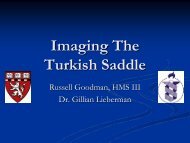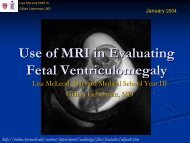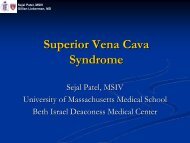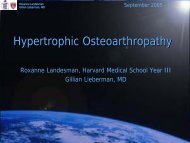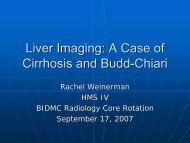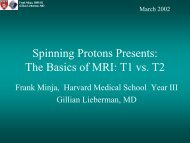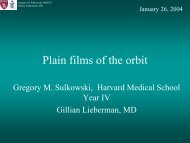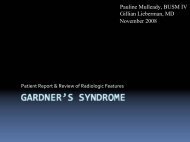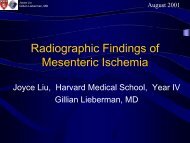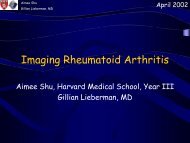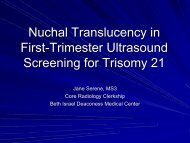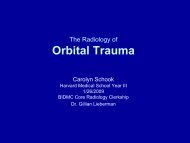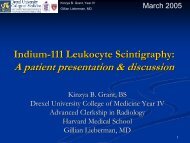The Roles of Radiologic Imaging in Sturge-Weber Syndrome
The Roles of Radiologic Imaging in Sturge-Weber Syndrome
The Roles of Radiologic Imaging in Sturge-Weber Syndrome
Create successful ePaper yourself
Turn your PDF publications into a flip-book with our unique Google optimized e-Paper software.
<strong>The</strong> <strong>Roles</strong> <strong>of</strong> <strong>Radiologic</strong> <strong>Imag<strong>in</strong>g</strong> <strong>in</strong><br />
<strong>Sturge</strong>-<strong>Weber</strong> <strong>Syndrome</strong><br />
Audrey S. Wang, HMS-III<br />
BIDMC Department <strong>of</strong> Radiology<br />
May 19, 2008
• Patient TR<br />
• <strong>The</strong> Phakomatoses<br />
Overview<br />
• <strong>Sturge</strong>-<strong>Weber</strong> <strong>Syndrome</strong><br />
– Cl<strong>in</strong>ical Features<br />
– Epidemiology<br />
– Pathogenesis<br />
• Patient TR: <strong>Imag<strong>in</strong>g</strong><br />
• Companion Patient RW<br />
• Summary
Patient TR<br />
• Newborn baby girl with a<br />
L-sided Port-W<strong>in</strong>e Sta<strong>in</strong><br />
primarily <strong>in</strong> the V1<br />
distribution at birth<br />
• L-sided ocular glaucoma<br />
What should we be<br />
concerned about? http://www.childrenshospital.org/cl<strong>in</strong>ic<br />
alservices/Site2566/ma<strong>in</strong>pageS2566<br />
P7.html
Patient TR: <strong>Sturge</strong>-<strong>Weber</strong> <strong>Syndrome</strong>?<br />
She has classic features <strong>of</strong> <strong>Sturge</strong>-<strong>Weber</strong><br />
<strong>Syndrome</strong>, a phakomatosis.
<strong>The</strong> Phakomatoses<br />
• “Phakos” (Gr.) = birth mark, spot, mole<br />
• Neurocutaneous syndromes/Congenital<br />
neuroectodermal dysplasias:<br />
– Neur<strong>of</strong>ibromatosis<br />
– Tuberous Sclerosis<br />
– Von Hippel L<strong>in</strong>dau<br />
– <strong>Sturge</strong>-<strong>Weber</strong> <strong>Syndrome</strong> (SWS)<br />
• the only phakomatosis that is NOT associated with<br />
<strong>in</strong>tracranial neoplasms (Di Rocco and Tamburr<strong>in</strong>i, 2006)
SWS: Classic Cl<strong>in</strong>ical Features<br />
• Encephalotrigem<strong>in</strong>al<br />
angiomatosis:<br />
– Capillary-venous malformation<br />
(leptomen<strong>in</strong>geal<br />
angiomatosis)<br />
– Facial port-w<strong>in</strong>e sta<strong>in</strong> (PWS or<br />
nevus flammeus) <strong>in</strong> trigem<strong>in</strong>al<br />
V1-V3 distribution<br />
– Congenital glaucoma<br />
– Intractable epilepsy<br />
– Progressive mental<br />
retardation<br />
http://www.childrenshospital.org/cl<strong>in</strong>ic<br />
alservices/Site2566/ma<strong>in</strong>pageS2566<br />
P7.html
SWS: Epidemiology<br />
• Rare (estimated 1/50,000 live births)<br />
• Sporadic<br />
• Affects males and females with equal<br />
frequency<br />
• No racial bias<br />
(Di Rocco and Tamburr<strong>in</strong>i, 2006)
SWS: Classification<br />
SWS Type Cl<strong>in</strong>ical Features<br />
1 (“classic”) Facial and <strong>in</strong>tracranial manifestations<br />
2 Facial lesion only (primarily dermatological)<br />
3 Intracranial manifestations without facial<br />
lesions<br />
(Adapted from Tortori-Donati et al, 2005)<br />
• Overall risk <strong>of</strong> PWS associated with leptomen<strong>in</strong>geal<br />
angiomatosis: ~8%<br />
– In the first year <strong>of</strong> life, 75-90% <strong>of</strong> these patients develop<br />
seizures, about 60% <strong>of</strong> which become progressively refractory to<br />
medical treatment<br />
– May require surgical lobectomy or hemispherectomy if severe<br />
(Di Rocco and Tamburr<strong>in</strong>i, 2006)
SWS: Pathogenesis<br />
• SWS is thought to develop from localized<br />
primary venous dysplasia, unrelated to any<br />
trigem<strong>in</strong>al nerve dysfunction.<br />
– <strong>The</strong> facial distribution <strong>of</strong> PWS appears to be<br />
co<strong>in</strong>cidental (Parsa, 2008).<br />
• Dur<strong>in</strong>g development at ~4-5 weeks gestation, a<br />
primordial s<strong>in</strong>usoidal vascular plexus forms<br />
around the cephalic portion <strong>of</strong> the neural tube<br />
and under the ectoderm that later becomes<br />
facial sk<strong>in</strong>.<br />
– This vascular plexus normally regresses at ~9 weeks<br />
gestation (Tortori-Donati et al, 2005).
SWS: Pathogenesis<br />
• In SWS, cortical bridg<strong>in</strong>g ve<strong>in</strong>s fail to form, the<br />
vascular plexus persists, and the rema<strong>in</strong><strong>in</strong>g ve<strong>in</strong>s<br />
become engorged with redirected blood flow<br />
(Parsa, 2008).<br />
Intraoperative images show<strong>in</strong>g leptomen<strong>in</strong>geal “angiomatosis,”<br />
reflect<strong>in</strong>g venous engorgement with diffuse hemispheric <strong>in</strong>volvement<br />
<strong>in</strong> (a) and more focal <strong>in</strong>volvement <strong>in</strong> (b). (Di Rocco and Tamburr<strong>in</strong>i, 2006)
Cerebral Ve<strong>in</strong>s are Emissary Ve<strong>in</strong>s<br />
* Key po<strong>in</strong>t: Because all emissary ve<strong>in</strong>s lack<br />
valves, they allow for bidirectional flow.<br />
Let’s review the cerebral venous system to<br />
better understand the key features <strong>of</strong> SWS.
Normal Cerebral Venous System<br />
Superior<br />
sagittal<br />
s<strong>in</strong>us<br />
Cortical<br />
bridg<strong>in</strong>g<br />
ve<strong>in</strong>s<br />
Cavernous<br />
s<strong>in</strong>us<br />
(Modified from<br />
Nolte, J., 2002)<br />
<strong>The</strong> superficial parts <strong>of</strong> the bra<strong>in</strong> are primarily dra<strong>in</strong>ed by the superior sagittal s<strong>in</strong>us,<br />
while the deeper structures are dra<strong>in</strong>ed by the cavernous s<strong>in</strong>us, straight s<strong>in</strong>us, and<br />
other deep ve<strong>in</strong>s. <strong>The</strong> cortical bridg<strong>in</strong>g ve<strong>in</strong>s serve as the conduits that connect the<br />
two venous systems, which ultimately dra<strong>in</strong> <strong>in</strong>to the <strong>in</strong>ternal jugular ve<strong>in</strong>.
Abnormal Venous Dra<strong>in</strong>age <strong>in</strong> SWS<br />
• With absent or fewer<br />
cortical bridg<strong>in</strong>g ve<strong>in</strong>s,<br />
normal cerebral<br />
outflow is impaired,<br />
lead<strong>in</strong>g to<br />
engorgement <strong>of</strong> the<br />
rema<strong>in</strong><strong>in</strong>g ve<strong>in</strong>s.<br />
• S<strong>in</strong>ce cerebral ve<strong>in</strong>s<br />
have bidirectional flow,<br />
venous blood can<br />
travel to superficial<br />
(e.g. leptomen<strong>in</strong>geal,<br />
facial) ve<strong>in</strong>s or to deep<br />
ve<strong>in</strong>s/s<strong>in</strong>uses,<br />
<strong>in</strong>clud<strong>in</strong>g the choroidal<br />
plexus ve<strong>in</strong>s and<br />
ophthalmic ve<strong>in</strong>s.<br />
(Modified from Parsa, 2008)
Neurologic Deterioration <strong>in</strong><br />
SWS<br />
• Processes (<strong>in</strong>clud<strong>in</strong>g normal bra<strong>in</strong> development<br />
and seizures) that <strong>in</strong>crease the oxygen and<br />
glucose demand <strong>of</strong> bra<strong>in</strong> tissue lead to<br />
<strong>in</strong>creased cerebral blood flow.<br />
• <strong>The</strong>se changes exacerbate the pre-exist<strong>in</strong>g venous<br />
engorgement and further elevate venous pressures,<br />
result<strong>in</strong>g <strong>in</strong> more severe cerebral ischemia and tissue<br />
damage (Parsa, 2008).<br />
• With this <strong>in</strong> m<strong>in</strong>d, let’s return to Patient TR…
Back to Patient TR<br />
• Newborn baby girl with a L-sided Port-W<strong>in</strong>e<br />
Sta<strong>in</strong> <strong>in</strong> primarily the V1 distribution at birth<br />
• L-sided ocular glaucoma<br />
• We are concerned about <strong>in</strong>tracranial<br />
<strong>in</strong>volvement <strong>of</strong> SWS.<br />
Which imag<strong>in</strong>g modality should we use?
Pt TR: MRI Bra<strong>in</strong> (4 days old)<br />
• MRI is optimal for s<strong>of</strong>t tissue<br />
imag<strong>in</strong>g; therefore, it is the<br />
modality <strong>of</strong> choice to evaluate<br />
for white or gray matter<br />
alterations, vascular<br />
abnormalities, and parenchymal<br />
volume loss.<br />
– Superior to CT for correlation with<br />
cl<strong>in</strong>ical status (Marti-Bonmati et al,<br />
1993)<br />
• Axial T1-weighted FLAIR, post-<br />
gadol<strong>in</strong>ium:<br />
– Slight asymmetry <strong>of</strong> the vessels<br />
over the L high convexity; no other<br />
significant f<strong>in</strong>d<strong>in</strong>gs<br />
PACS, Children’s Hospital Boston
Pt TR: MRI Bra<strong>in</strong> (4 days old)<br />
• History <strong>of</strong> L-sided glaucoma and choroid<br />
“hemangioma”<br />
Axial T1-weighted post-gad<br />
Increased enhancement,<br />
thickness <strong>of</strong> L choroid relative to R<br />
Not a true hemangioma; <strong>in</strong>stead, reflects<br />
engorgement <strong>of</strong> pre-exist<strong>in</strong>g vessels, related to<br />
<strong>in</strong>creased ocular venous pressure (Parsa, 2008)<br />
PACS, Children’s Hospital Boston
Pt TR: At 8 Months <strong>of</strong> Age<br />
• Patient TR presented to the ED with new-onset<br />
seizures/status epilepticus, R facial droop, and<br />
little spontaneous movement <strong>of</strong> her R arm.<br />
• No head trauma<br />
• No family history <strong>of</strong> seizures<br />
• Afebrile, vital signs with<strong>in</strong> normal limits<br />
What k<strong>in</strong>d <strong>of</strong> imag<strong>in</strong>g would you do to R/O<br />
possible causes <strong>of</strong> her seizures?
Pt TR: CT Bra<strong>in</strong> (8 months <strong>of</strong> age)<br />
• R/O acute <strong>in</strong>tracranial<br />
hemorrhage/<strong>in</strong>farction as<br />
the most urgent<br />
possibilities, also evaluate<br />
for mass lesions and<br />
hydrocephalus<br />
• Non-contrast Axial CT:<br />
– No sign <strong>of</strong> acute bleed,<br />
territorial <strong>in</strong>farct, mass<br />
lesions, or hydrocephalus<br />
– Bilateral subcortical<br />
m<strong>in</strong>eralization <strong>in</strong>volv<strong>in</strong>g the<br />
parietal and temporal lobes<br />
(L>R)<br />
– Parenchymal volume loss<br />
(L>R)<br />
PACS, Children’s Hospital Boston
DDx <strong>of</strong> Intracranial Calcifications<br />
• <strong>Sturge</strong>-<strong>Weber</strong> syndrome<br />
• Arteriovenous malformation<br />
• Hemangiomas<br />
• Choroid plexus<br />
• Craniopharyngioma<br />
• Glioma<br />
• Tuberculosis<br />
• Idiopathic<br />
(Reeder, 2003)<br />
PACS, Children’s Hospital Boston
“Tram-track<strong>in</strong>g” <strong>in</strong> SWS<br />
• Gyriform cortical calcifications<br />
on CT and pla<strong>in</strong> film due to:<br />
– Altered vessel wall permeability<br />
leakage <strong>of</strong> calcium phosphate<br />
or carbonate with subsequent<br />
secondary crystallization with<strong>in</strong><br />
perivascular parenchyma<br />
– Dystrophic calcification: related<br />
to prolonged convulsive states<br />
with local ischemia anoxia,<br />
neuronal necrosis<br />
Posteroanterior skull radiograph.<br />
(Akp<strong>in</strong>ar, 2004)<br />
• Calcifications develop over time, usually beg<strong>in</strong>n<strong>in</strong>g at<br />
>2 yrs <strong>of</strong> age<br />
(Di Rocco and Tamburr<strong>in</strong>i, 2006)
Pt TR: MRI Bra<strong>in</strong> (8 months <strong>of</strong> age)<br />
• Evaluate for s<strong>of</strong>t tissue<br />
changes, vascular<br />
abnormalities<br />
• Axial MPGR<br />
Susceptibility:<br />
– Progressive cerebral<br />
atrophy with widened<br />
subarachnoid space<br />
– Increased<br />
leptomen<strong>in</strong>geal<br />
enhancement <strong>in</strong>volv<strong>in</strong>g<br />
both cerebral<br />
hemispheres (L>R)<br />
PACS, Children’s Hospital Boston
Pt TR: At 2 Years <strong>of</strong> Age<br />
• Patient TR presented to the ED with an<br />
<strong>in</strong>creas<strong>in</strong>g frequency <strong>of</strong> seizures and a<br />
change from her basel<strong>in</strong>e seizure<br />
characteristics<br />
• Developmental delay was noted on exam<br />
What k<strong>in</strong>d <strong>of</strong> imag<strong>in</strong>g would you do?
PT TR: CT Bra<strong>in</strong> (2 yrs <strong>of</strong> age)<br />
• R/O <strong>in</strong>tracranial bleed due to<br />
concern for change <strong>in</strong> seizure<br />
characteristics; evaluate for<br />
SWS progression<br />
• Non-contrast Axial CT:<br />
– Interval progression <strong>of</strong> marked<br />
gyriform cerebral calcification and<br />
associated parenchymal volume<br />
loss (L>R).<br />
Compare<br />
with prior CT<br />
(at 8 mo):<br />
PACS, Children’s Hospital Boston
Pt TR: MRI Bra<strong>in</strong> (2 yrs <strong>of</strong> age)<br />
• Evaluate for <strong>in</strong>terval<br />
progression <strong>of</strong> SWS features<br />
• Axial T1-weighted, post-gad:<br />
– More pronounced b/l<br />
leptomen<strong>in</strong>geal enhancement,<br />
especially with<strong>in</strong> R parietal,<br />
temporal, occipital lobes<br />
– Engorgement <strong>of</strong> choroid plexus<br />
(related to impaired venous<br />
outflow)<br />
– Choroid plexus cysts<br />
PACS, Children’s Hospital Boston
Pt TR: MRI Bra<strong>in</strong> (2 yrs <strong>of</strong> age)<br />
• Axial gradient echo:<br />
– Dilated collateral<br />
ve<strong>in</strong>s<br />
– Calcifications<br />
appear dark<br />
Calcifications are<br />
more prom<strong>in</strong>ent<br />
on CT:<br />
PACS, Children’s Hospital Boston
Patient TR: Management<br />
• Patient TR’s seizures responded to<br />
oxcarbazep<strong>in</strong>e and valproic acid.<br />
• She was discharged home on these<br />
anticonvulsants with <strong>in</strong>structions to follow<br />
up with the neurology service.
Companion Patient RW: History<br />
• Boy with <strong>Sturge</strong>-<strong>Weber</strong> <strong>Syndrome</strong> with<br />
associated R-sided facial port-w<strong>in</strong>e sta<strong>in</strong> <strong>in</strong><br />
V1 distribution<br />
• Diagnosed at 5 weeks <strong>of</strong> age with SWS<br />
based on MRI f<strong>in</strong>d<strong>in</strong>gs<br />
• First seizures presented at 6 months <strong>of</strong><br />
age<br />
Let’s look at some imag<strong>in</strong>g.
Pt RW: What do you see?<br />
Leptomen<strong>in</strong>geal enhancement Cortical calcifications<br />
Contrast-enhanced Axial T1<br />
weighted MRI (5 wks <strong>of</strong> age)<br />
Non-contrast Axial CT (6 months <strong>of</strong> age)<br />
PACS, Children’s Hospital Boston
Pt RW: Rapid Progression on MR<br />
(Axial T1-weighted Post-gad Images)<br />
Leptomen<strong>in</strong>geal enhancement Parenchymal atrophy<br />
PACS, Children’s Hospital Boston<br />
5 wks <strong>of</strong> age<br />
9 mo <strong>of</strong> age<br />
Choroid plexus enlargement
Pt RW: Progression to Intractable<br />
Seizures<br />
• Patient RW cont<strong>in</strong>ued to have seizures, which<br />
became refractory to medical therapy.<br />
• Surgical options were considered to remove the<br />
epileptogenic focus and protect the normal bra<strong>in</strong><br />
from excitotoxic <strong>in</strong>jury secondary to the seizures.<br />
How can we functionally determ<strong>in</strong>e the extent<br />
<strong>of</strong> bra<strong>in</strong> <strong>in</strong>volvement?
Nuclear <strong>Imag<strong>in</strong>g</strong>: PET<br />
• Positron Emission Tomography<br />
• F-18-FDG (Fluorodeoxyglucose)<br />
– Measure F-18-FDG metabolism <strong>in</strong> bra<strong>in</strong> tissue<br />
to determ<strong>in</strong>e its metabolic function<br />
• More recently used for prognostic<br />
evaluation and to aid surgical plann<strong>in</strong>g<br />
– Extent and severity <strong>of</strong> FDG hypometabolism<br />
have been shown to correlate with seizure<br />
severity and cognitive decl<strong>in</strong>e (Lee et al, 2001)
Pt RW: Pre-surgical Evaluation with<br />
Bra<strong>in</strong> PET<br />
PET scan shows decreased FDG uptake throughout the R cerebrum,<br />
suggest<strong>in</strong>g decreased metabolic activity with<strong>in</strong> the entire hemisphere,<br />
which correlates with the region <strong>of</strong> cerebral hemiatrophy seen on MRI.<br />
Normal FDG<br />
uptake is<br />
denoted by<br />
the yellow<br />
regions.<br />
Axial T1w MRI PET Image Image Overlay<br />
PACS, Children’s Hospital Boston
Pt RW: Management<br />
PET scann<strong>in</strong>g demonstrated diffuse reduction <strong>in</strong><br />
metabolic activity throughout the entire R cerebrum.<br />
<strong>The</strong>refore, the decision was made for Patient RW<br />
to undergo R cerebral hemispherectomy.
Pt RW: s/p R Cerebral Hemispherectomy<br />
CSF<br />
Contrast-enhanced Coronal T1w MRI<br />
CSF<br />
Contrast-enhanced Axial T2w MRI<br />
PACS, Children’s Hospital Boston
Let’s Review<br />
• You have been <strong>in</strong>troduced to two different<br />
patients with <strong>Sturge</strong>-<strong>Weber</strong> <strong>Syndrome</strong>.<br />
• Both demonstrated classic radiologic<br />
f<strong>in</strong>d<strong>in</strong>gs on MRI and CT but cl<strong>in</strong>ically<br />
progressed at different rates.<br />
• One patient’s seizures were managed<br />
medically, but the other patient’s became<br />
<strong>in</strong>tractable, requir<strong>in</strong>g surgical <strong>in</strong>tervention.<br />
We can use what we have learned from these two patients to<br />
construct a simple algorithm for the diagnosis and management <strong>of</strong><br />
SWS patients <strong>in</strong> general.
SWS: Algorithm for Dx and Management<br />
Facial port-w<strong>in</strong>e sta<strong>in</strong> at birth <strong>in</strong> V1-V3 distribution<br />
R/O <strong>in</strong>tracranial <strong>in</strong>volvement<br />
with radiologic imag<strong>in</strong>g<br />
Leptomen<strong>in</strong>geal enhancement<br />
and parenchymal atrophy (MRI);<br />
gyriform calcifications (CT)?<br />
Repeat imag<strong>in</strong>g if<br />
develop cl<strong>in</strong>ical<br />
symptoms (e.g.<br />
seizures)<br />
No Yes<br />
Dermatologic<br />
evaluation for laser<br />
Rx <strong>of</strong> nevus for<br />
cosmetic concerns<br />
Close neurology follow-up with radiologic<br />
documentation <strong>of</strong> <strong>in</strong>tracranial progression<br />
if cl<strong>in</strong>ical status changes; manage<br />
seizures medically<br />
Consider surgical management if refractory to<br />
medical therapy; employ functional imag<strong>in</strong>g (PET)<br />
for prognostic and pre-surgical evaluation<br />
Ophthalmologic<br />
evaluation for<br />
glaucoma
Summary<br />
• <strong>Sturge</strong>-<strong>Weber</strong> <strong>Syndrome</strong> is a rare,<br />
sporadic condition due to primary venous<br />
dysplasia caus<strong>in</strong>g impaired venous outflow<br />
and subsequent cerebral ischemia.<br />
• Certa<strong>in</strong> types can progress to <strong>in</strong>tractable<br />
epilepsy and may necessitate radical<br />
surgical <strong>in</strong>tervention.<br />
• <strong>Radiologic</strong> imag<strong>in</strong>g plays several key roles<br />
<strong>in</strong> the management <strong>of</strong> SWS patients.
Summary - 2<br />
• MRI correlates better than CT with cl<strong>in</strong>ical<br />
progression.<br />
– Confirms the diagnosis <strong>of</strong> <strong>in</strong>tracranial<br />
<strong>in</strong>volvement<br />
– Helps document the extent <strong>of</strong> <strong>in</strong>volvement<br />
(e.g. R/O bilateral SWS)<br />
• CT is more sensitive than MRI for<br />
detect<strong>in</strong>g cortical calcifications.
Summary - 3<br />
• PET <strong>of</strong>fers functional (metabolic activity)<br />
data to determ<strong>in</strong>e the full extent <strong>of</strong><br />
<strong>in</strong>volvement <strong>of</strong> the bra<strong>in</strong> parenchyma.<br />
– Complements MRI/CT f<strong>in</strong>d<strong>in</strong>gs<br />
– Provides prognostic <strong>in</strong>formation that can help<br />
guide management, <strong>in</strong>clud<strong>in</strong>g surgical<br />
plann<strong>in</strong>g
Acknowledgements<br />
• Dr. Jason Handwerker<br />
(Children’s Hospital Boston,<br />
Radiology)<br />
• Dr. Marilyn Liang<br />
(Children’s Hospital Boston,<br />
Dermatology)<br />
• Dr. Kei Yamada<br />
(BIDMC, Radiology)<br />
• Dr. Gillian Lieberman<br />
(BIDMC, Radiology)<br />
• Maria Levantakis<br />
(BIDMC, Radiology) http://www.childrenshospital.org/cl<strong>in</strong>ic<br />
alservices/Site2566/ma<strong>in</strong>pageS2566<br />
P7.html
References<br />
• Akp<strong>in</strong>ar E. <strong>The</strong> tram-track sign: cortical calcifications. Radiology. 2004;231:515-6.<br />
• Di Rocco C, Tamburr<strong>in</strong>i G. <strong>Sturge</strong>-<strong>Weber</strong> syndrome. Childs Nerv Syst. 2006;22:909-21.<br />
• Lee JS, Asano E, Muzik O, Chugani DC, Juhász C, Pfund Z, Philip S, Behen M, Chugani<br />
HT. <strong>Sturge</strong>-<strong>Weber</strong> syndrome: correlation between cl<strong>in</strong>ical course and FDG PET f<strong>in</strong>d<strong>in</strong>gs.<br />
Neurology. 2001;57:189-95.<br />
• Martí-Bonmatí L, Menor F, Mulas F. <strong>The</strong> <strong>Sturge</strong>-<strong>Weber</strong> syndrome: correlation between<br />
the cl<strong>in</strong>ical status and radiological CT and MRI f<strong>in</strong>d<strong>in</strong>gs. Childs Nerv Syst. 1993;9:107-9.<br />
• Nolte, J. <strong>The</strong> Human Bra<strong>in</strong>: An Introduction to Its Functional Anatomy, 5th ed. St. Louis:<br />
Mosby, 2002.<br />
• Parsa CF. <strong>Sturge</strong>-<strong>Weber</strong> <strong>Syndrome</strong>: A Unified Pathophysiologic Mechanism. Curr Treat<br />
Options Neurol. 2008;10:47-54.<br />
• Reeder MM. Reeder and Felson’s Gamuts <strong>in</strong> Radiology, 4th ed. New York: Spr<strong>in</strong>ger,<br />
2003.<br />
• Tortori-Donati P, Rossi A, Biancheri R, Andreula CF. Pediatric Neuroradiology: Bra<strong>in</strong>.<br />
Berl<strong>in</strong>: Spr<strong>in</strong>ger, 2005.<br />
• Children’s Hospital Boston - <strong>Sturge</strong>-<strong>Weber</strong> <strong>Syndrome</strong> Cl<strong>in</strong>ic.<br />
http://www.childrenshospital.org/cl<strong>in</strong>icalservices/Site2566/ma<strong>in</strong>pageS2566P7.html<br />
Accessed 5/18/2008.



